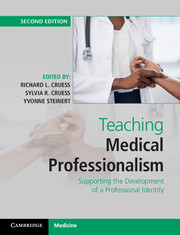Book contents
- Frontmatter
- Contents
- List of contributors
- Foreword
- Introduction
- Part I What is to be taught and learned
- Part II Theory
- Part III Principles
- Part IV Case studies in promoting professionalism and professional identity formation across the continuum
- 15 The evolution of an undergraduate medical program on professionalism and identity formation
- 16 Developing and implementing an undergraduate curriculum
- 17 Supporting professionalism and professional identity formation at the postgraduate level
- 18 Changing the educational environment to better support professionalism and professional identity formation
- Part V The future
- Index
- References
16 - Developing and implementing an undergraduate curriculum
from Part IV - Case studies in promoting professionalism and professional identity formation across the continuum
Published online by Cambridge University Press: 05 April 2016
- Frontmatter
- Contents
- List of contributors
- Foreword
- Introduction
- Part I What is to be taught and learned
- Part II Theory
- Part III Principles
- Part IV Case studies in promoting professionalism and professional identity formation across the continuum
- 15 The evolution of an undergraduate medical program on professionalism and identity formation
- 16 Developing and implementing an undergraduate curriculum
- 17 Supporting professionalism and professional identity formation at the postgraduate level
- 18 Changing the educational environment to better support professionalism and professional identity formation
- Part V The future
- Index
- References
Summary
Texas has a reputation comparable to its size, for doing things in a big way and for being individualistic. This chapter presents a Texas-sized pilot study that includes six undergraduate institutions and four medical schools engaged in an initiative to transform medical education. A fundamental part of the transformation is the authentic integration of professional identity formation into premedical and undergraduate medical education.
Time initiative
In 2007, the University of Texas (UT) System launched Transformation in Medical Education (TIME), a broad initiative to redesign the continuum of premedical to undergraduate medical education. This ambitious project, funded by the UT Regents and championed by the Executive Vice Chancellor for Health Affairs, aimed to reform the content, methods, and timeline of the attainment of the medical degree, based on the belief that current methods are inefficient, outdated, and unnecessarily long and expensive. The TIME steering committee identified four foundational elements for the initiative: (1) instituting a pre-health-professions program; (2) implementing competency-based education; (3) incorporating nontraditional topics; and (4) intentionally focusing on professional identity formation.
Within the TIME initiative, six undergraduate campuses and four medical schools across the UT System created four pilot program partnerships. Each partnership included one to three undergraduate campuses and one or two medical schools, with the goal of developing and implementing a pilot that incorporates all four foundational elements. The heterogeneity of the partnerships and their pilots provided the opportunity to identify successful designs and strategies as well as lessons learned. This heterogeneity also extended to methods of student selection, number of institutions, curriculum design, and geographic spread, which ranges from eight to 800 miles between partner institutions.
As the first TIME initiative element, each undergraduate campus established a pre-health-professions program. By including students interested in a variety of health professions, these programs allow students to share experiences and learn collaboratively, with the goal of fostering teamwork and interprofessional professionalism. These programs also provide a structure for developing and managing educational activities and tracking student progress.
The second TIME initiative element, competency-based education, grew from the work of the Accreditation Council on Graduate Medical Education (ACGME) and the Royal College of Physicians and Surgeons of Canada to incorporate competency-based principles into postgraduate medical education.1,2 Undergraduate medical education has since adopted competency-based medical education, including the development of graduation competencies.
- Type
- Chapter
- Information
- Teaching Medical ProfessionalismSupporting the Development of a Professional Identity, pp. 231 - 247Publisher: Cambridge University PressPrint publication year: 2016
References
- 1
- Cited by

